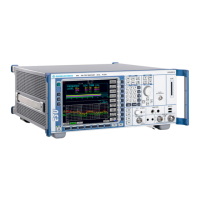Operating Manual 1302.6163.12 - 03 4.165
R&S ESU Instrument Functions
Analyzer Mode
The MKR->CF STEPSIZE function is, above all, useful in the measurement of har-
monics with large dynamic range (narrow bandwidth and narrow span).
The softkey is not available in the time domain (span = 0 Hz).
Remote command: CALC:MARK:FUNC:CST
Example
The harmonics levels of a CW carrier are to be measured at 100 MHz.
MIN
The MIN softkey sets the active marker/delta marker to the minimum of the selected
trace.
Remote command: CALC:MARK:MIN
CALC:DELT:MIN
NEXT MIN
The NEXT MIN softkey sets the active marker/delta marker to the next higher mini-
mum of the selected trace.
Remote command: CALC:MARK:MIN:NEXT
CALC:DELT:MIN:NEXT
NEXT MIN
RIGHT
The NEXT MIN RIGHT softkey sets the active marker/delta marker to the next
higher minimum right of the current marker position on the selected trace.
Remote command: CALC:MARK:MIN:RIGH
CALC:DELT:MIN:RIGH
NEXT MIN
LEFT
The NEXT MIN LEFT softkey sets the active marker/delta marker to the next higher
minimum left of the current marker position on the selected trace.
Remote command: CALC:MARK:MIN:LEFT
CALC:DELT:MIN:LEFT
[PRESET] R&S ESU is set to the default setting.
[CENTER: 100 MHz] R&S ESU sets the center frequency to 100 MHz. The span
is set to 200 MHz.
[SPAN: 1 MHz] The span is set to 100 MHz.
[MKR->] MARKER 1 is switched on and set to the maximum value
of the signal.
[NEXT] R&S ESU switches to the submenu.
[MKR->CF STEPSIZE] The step size of the center frequency setting equals the
marker frequency (100 MHz).
[CENTER] The center frequency entry mode is activated.
[Right key] The center frequency is set to 200 MHz. The first harmonic
of the test signal is displayed.
[MKR->: PEAK] The marker is set to the harmonic and the level of the latter
is output in the marker info field.

